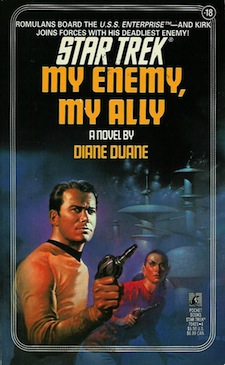Diane Duane writes the most alien aliens in the Star Trek universe. She’s written the Horta, a race of glass spiders, and a second species of talking rock. She questions the relationships between these species and humanity, the Federation, and the fabric of space and time. She writes about them in incredible detail. By the time she’s done, you know how they think of themselves, what they think of you, and what they regard as tasty snacks.
In her 1984 novel, My Enemy, My Ally, Duane took on the Romulans. And although it’s really not unlike a lot of Duane’s other work on other alien races, it’s a stunning demonstration of what she can do.
In the original Star Trek television series, the Klingons and Romulans were both allegorically Soviet. The Klingons were brute-force totalitarians, while the Romulans were mysterious covert operatives. Both were convenient to keeping the show’s vision for humanity’s unified future relevant in an era of Cold War anxiety. Duane doesn’t wipe out this vision of the Romulans—she complicates it until we understand how to connect with it again.
Duane’s version tackles the question, why would Romulans call themselves Romulans? The name is a reference to Terran mythology and whatever you may believe about the shared origins of humanoid species in the universe, Romulans aren’t Terrans. So while they may agree that Romulus is a cool guy, and that being raised by a wolf to found a city that builds a continent-spanning Empire makes a cool story, they must have had a name for themselves well before they heard about Rome. They call themselves the Rihannsu, after their planet, ch’Rihan. And the Rihannsu aren’t just like us with funny ears—they’re dramatically different from us despite significant phenotypical similarities.
One of those differences is language; the Rihannsu do not speak English. When they talk to Federation officers, they speak Federation Standard. Once they get transdermal universal translators, everyone understands them, but until then, they speak Rihannsu. “Great!” you’re thinking, “I’ll bust out my Rihannsu dictionary from my collection of vintage Trek stuff and follow along!” Think again, because there is no official Rihannsu dictionary. This appears to have something to do with the Powers That Were regarding Trek-related licensed properties. Having to guess what the Rihannsu are talking about is vital to getting your head into this book; this is a book about aliens, and you don’t understand them.
What you understand instead is the major symbolic motif in the piece. Duane’s Trek novels usually have a play within a play. Doctor’s Orders takes you to Switzerland, and then to space, where you rediscover Switzerland. Spock’s World has nested layers of symbolism with bonus sand whales. My Enemy, My Ally has four-dimensional chess. It’s a game, it’s a personality test, and it’s the plot. In four-dimensional chess, pieces can be timed out of the 3D cube to reappear later. It’s of a piece with Duane’s strategic use of Rihannsu—your understanding of what the characters are talking about is periodically timed out so it can be dropped on you later if Duane feels like it. Everything is a piece on the chessboard.
The Rihannsu dialogue does appear, to my completely untrained eye, to be internally consistent with itself. You will likely pick up a key phrase or two by the end of the book. If you’re the kind of reader who wants to do some frequency analysis and some careful comparisons of Rihannsu dialogue to characters’ thoughts, it might be really thrilling. But for a lot of readers, the dialogue will be mostly gibberish. However, this is the first in a series of books in which Duane explains Rihannsu culture (like Mike Ford explained Klingon culture) in stunning detail, and in a way that was later excluded from the official Star Trek canon despite the affection with which it is regarded by fans. It’s worth muddling through a mostly-untranslatable alien language.
My Enemy, My Ally reveals Rihannsu culture by bringing the Rihannsu protagonist, Ael t’Rllaillieu on board the Enterprise on a mission to undermine a conspiracy that involves several crews of Vulcans captured by nefarious Rihannsu involved in an unscrupulous biological research program intended to give Rihannsu psychic powers that rival those of their Vulcan cousins. To facilitate this conspiracy, the Rihannsu have developed a way to control the space weather. This seems to me like a cooler power than reading minds while touching people like Vulcans do, or even than reading minds from a distance, like the Rihannsu conspirators are planning to do. But evidently, the edge that indiscriminate, ethically unchecked use of psychic powers would give individuals in Rihannsu internal politics is more important and useful than the ability to create apparently natural ion storms that disrupt warp travel and interspace communications. And so the Rihannsu are moving in to the neutral zone to capture passing Vulcans and use their enhanced neural tissue to stomp out telepathic illiteracy among their political elites. They have to be stopped.
How do you stop an evil plan of this magnitude? There’s a complex scheme involving a clever ruse to make it look like the Enterprise has been captured by Rihannsu. For verisimilitude, a crew of Rihannsu moves over to the Enterprise and does jujitsu on the Recreation Deck. They do other things too, but these moments are the most important. If the disappearing-reappearing chess pieces of your understanding bother you, ignore the plot and read for these beautiful moments of cross-cultural interaction. These are the moments the story exists to serve—Ael laughing hysterically at Kirk’s given name, the comparisons between the conditions on the Enterprise and those in the Rihannsu fleet, Ael’s reminiscences about her father’s lessons in honor, and the deeply tragic moment when Kirk becomes the only person who knows Ael’s fourth name.
Ellen Cheeseman-Meyer teaches history and reads a lot.










